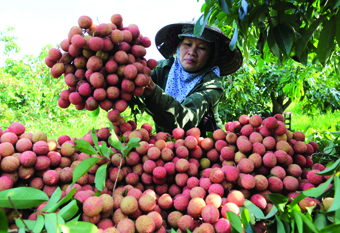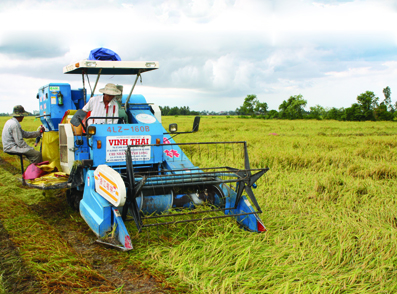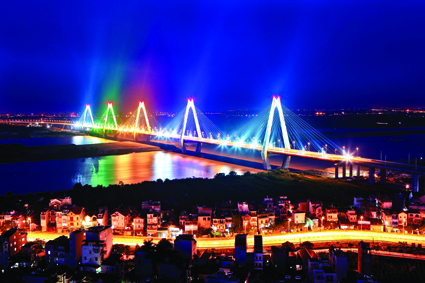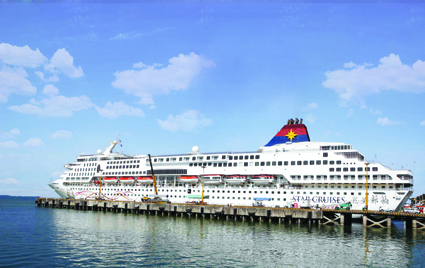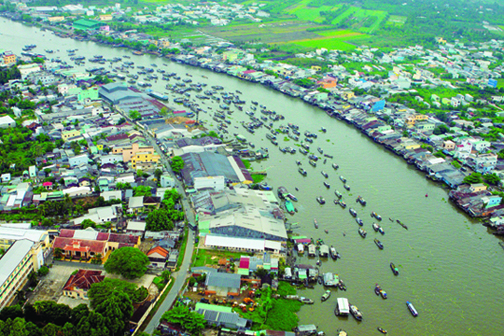Located 50km to the north of Hanoi capital, Bac Giang province borders Lang Son province in the north, Quang Ninh province in the east, Thai Nguyen province and Hanoi in the west and Bac Ninh and Hai Duong provinces in the south. Covering some 3,840 square kilometers, the province has a population of more than 1.6 million people (by the end of 2014) and is home to 21 ethnic groups with Kinh (Viet) being the most populous, followed by Nung and Tay. It has a provincial city with the same name and nine districts (Hiep Hoa, Luc Nam, Luc Ngan, Yen Dung, Lang Giang, Son Dong, Tan Yen, Viet Yen and Yen The).
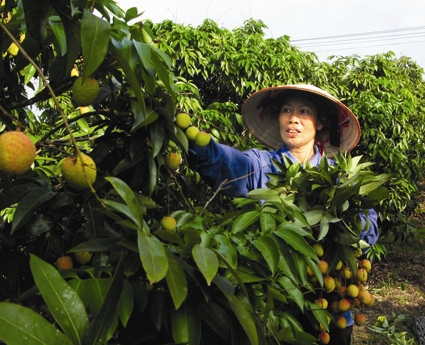 |
| Farmers in Tan Yen district, Bac Giang province, harvest litchi fruits__Photo: Duong Tri/VNA |
Foreign investment attraction
Bac Giang province lies in the Nanning (China) - Lang Son - Hanoi - Hai Phong economic corridor and is adjacent to the northern key economic region covering Hanoi, Hai Phong and Quang Ninh. The province is covered by the Hanoi regional construction master plan through 2030, with a vision to 2050.
Bac Giang is to date home to six industrial parks (IPs) covering a total area of almost 1,200 hectares, namely Dinh Tram, Quang Chau, Song Khe, Van Trung, Viet Han, Chau Minh-Mai Dinh, and 32 industrial clusters. It has planned the construction of nine IPs occupying 3,500 hectares to welcome investors.
According to the Foreign Investment Agency under the Ministry of Planning and Investment, by the end of the first quarter of the year, Bac Giang ranked 26th among 63 provinces and cities nationwide in foreign direct investment (FDI) attraction with 182 valid projects capitalized at USD 2.26 billion. During the reviewed period, the manufacturing sector attracted the largest share of FDI with 161 projects worth USD 2.03 billion.
At present, 14 countries and territories have been investing in the province. Samoa ranks first with a registered investment of USD 1.23 billion in two projects. In the first three months of this year, the province licensed 14 projects and permitted two existing projects to add their investment capital. Both ongoing and newly registered projects are capitalized at a total of USD 114.64 million.
The provincial administration said foreign-invested enterprises had contributed VND 150 billion to the state budget and generated jobs for around 67,000 local workers.
The Provincial Planning and Investment Department said Japan ranked third by the number of investment projects and the fourth by the registered capital in the province. The country of rising sun had 17 enterprises operating in the provincial IPs with a total capital of USD 127 million, of which nearly USD 75 million were disbursed.
Director of the provincial Investment Promotion and Enterprise Support Center Tran Duc Khiem said the Japan External Trade Organization (JETRO) and some 20 Japanese investors entered to explore investment opportunities in Bac Giang province in early March.
The Japanese investors highlighted the provincial investment climate as well as the advantages of its geographical location, land rent rates and human resources.
Shigeaki Hashimoto, director of Japan’s Nichirin Co. Ltd, which is specialized in manufacturing and sale of automotive and motorcycle hoses, was strongly impressed by the provincial administration’s constant efforts to improve the investment environment and their support for enterprises operating in the locality.
Bac Giang will continue being an attractive destination for foreign investors, he said.
The province is calling for investment in eight projects this year. The two BT (build-transfer) projects are the VND 700-billion belt road expansion project in Thang township (Hiep Hoa district) and the VND 350-billion project on water drainage and wastewater treatment system in Chu township (Luc Ngan district).
The remaining six projects funded with capital sources mobilized from all economic sectors, including the household garbage treatment plant in Bac Giang city, an entertainment center and a high-quality school in Lang Giang district and a stadium, a multi-sports competition hall and a children’s palace in Luc Ngan district, will soon be implemented.
To faciliate the implementation of the above projects, the province is determined to improve its Provincial Competitiveness Index (PCI), support enterprises in implementing their licensed projects, constantly step up reform of administrative procedures and apply the “single-window” mechanism and the quality management system ISO: 9001-2008 in the performance of administrative procedures in the field of investment.
According to Bui Thi Thu Thuy, deputy director of the provincial Planning and Investment Department, the master plan on socio-economic development of Bac Giang province through 2020, with a vision toward 2030, recently approved by the Prime Minister, will serve as an important “legal ground” for all sectors in the province to bring into full play potential and advantages to attract investment appropriately and efficiently.
She said the province would prioritize projects with modern and environment-friendly technologies capable of efficiently utilizing natural resources, encourages industrial projects to shift from processing to manufacturing and select prestigious and financially capable investors to create a spillover effect in investment attraction.
The province will also attach importance to development of small- and medium-sized projects suitable to each economic sector; attract enterprises engaged in prioritized industries to rural areas to create jobs for local laborers and actively support investment projects in areas with difficult or extremely difficult conditions, ensuring stable and sustainable development.
Tourism potential
Bac Giang province boasts a wealth of historical and cultural tradition with more than 2,230 historical relic sites, including over 100 nationally recognized relics. The most famous is Vinh Nghiem pagoda where Truc Lam, the Vietnamese Zen Buddhist sect, was founded by King Tran Nhan Tong in the 13th century. The pagoda in Yen Dung district now preserves more than 3,000 woodblocks of Buddhist canon, which have been recognized by UNESCO as a world memory heritage. They include also Tho Ha communal house in the revolutionary safety zone in Hiep Hoa district and relics of Yen The uprising during French colonial times.
Its Quan Ho (love duet singing) and Ca Tru (ceremonial singing) have been also recognized as intangible cultural heritage by UNESCO.
The province is endowed with beautiful landscapes, like the Suoi Mo eco-tourism site, Khuon Than and Cam Son lakes, western Yen Tu nature reserve, and Khe Ro primitive forest with highly diverse flora and fauna.
Bac Giang is renowned for not only Luc Ngan litchi but also traditional craft villages along the northern bank of Cau river, such as Tho Ha ceramics, Van rice wine, Tang Tien bamboo and rattan weaving and other local specialities.
Aware of the role of the non-smoke industry in its socio-economic development, Bac Giang has been implementing the master plan on the development of culture, sports and tourism through 2020, with a vision toward 2030, with various provincial plans on conservation of relics, tourism personnel training and promotion.
In 2014, Bac Giang received around 320,000 tourists and earned a turnover of around VND 192 billion.
Over the recent years, the province has organized conferences and participated in tourism cooperation programs with Thai Nguyen, Hai Duong, Quang Ninh, Son La and other neighboring provinces. It also invited representatives of a number of travel agents and media agencies from neighboring provinces to take part in tours to its scenic places with a view to promoting its image in the country.
In the past five years, Bac Giang spent billions dong on building infrastructure, upgrading and preserving cultural-historical relics in tourist zones and scenic places each year.
The province is expected to welcome 400,000 tourists, including 8,000 foreigners, this year and more than 1 million tourists by 2020. It hopes to attract tourists from other ASEAN member countries, and China, Japan, Western Europe and Northern America.
The province plans to develop ecological, traditional craft and adventure sports tourism.
To achieve the targets, Nguyen Van Linh, chairman of the provincial People’s Committee, has asked all sectors and the local authorities to strive to attract investment and facilitate local travel agents in establishing and expanding tourism linkages. He also called on the culture, sports and tourism sector to pay attention to improve the professional qualifications of local tourism staffs, provide special regimes to those who are thoroughly knowledgeable about the province’s history and culture and proficient in foreign languages, and adopt policies to attract investors.
The chairman also requested relevant agencies to finalize plans on Suoi Mo and Dong Cao eco-tourism sites and upgrade roads linking tourism spots within the province and to tourism attractions in neighboring provinces.-
